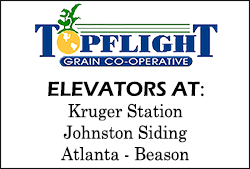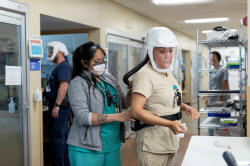Blip or bad moon rising? Fed meets amid COVID-19 surge, inflation
jitters
 Send a link to a friend
Send a link to a friend
 [July 28, 2021] By
Howard Schneider [July 28, 2021] By
Howard Schneider
WASHINGTON (Reuters) - The Federal Reserve
will conclude its latest policy meeting on Wednesday weighing the risks
of a COVID-19 resurgence in the United States and a potentially slower
economic recovery against a developing inflation threat that had been
its main focus.
Fed officials are expected to continue their debate over when to wean
the economy from the measures put in place more than a year ago to fight
the pandemic's economic aftershock, and in particular to discuss when to
reduce the $120 billion in Treasury bonds and mortgage-backed securities
the U.S. central bank is buying each month to hold down long-term
interest rates.

But that discussion, begun in earnest just six weeks ago when U.S. cases
of COVID-19 were falling under the influence of vaccinations, has been
complicated by the rapid spread of the more infectious Delta variant of
the virus, the renewal of crisis conditions in some hospitals, and
reinstated mask mandates in some cities.
Though focused mostly on the 40% of the adult U.S. population that
remains unvaccinated, the current outbreak nevertheless raises fresh
tensions for the Fed over whether planning to fend off inflation should
be the top concern at a time when the health crisis may yet curb an
otherwise ebullient recovery.
Graphic: Infections rise again:
https://graphics.reuters.com/USA-ECONOMY/CORONAVIRUS/
akpezggydvr/chart.png
"Sadly, (Fed Chair Jerome) Powell will have to acknowledge the downside
risks that are beginning to emerge," Diane Swonk, chief economist at
Grant Thornton, wrote ahead of the Fed's two-day policy meeting this
week. "The question mark is how spread of the Delta variant affects the
return to work and whether it dampens some of the demand for services"
that had begun to lead the recovery and pull millions of sidelined
people back into jobs.

The economy still is 6.8 million jobs short of where it was before the
pandemic's onset in early 2020, and Powell has said the country remains
"a ways off" from the progress he wants to see before changing any of
the Fed's efforts at encouraging job growth. Powell will hold a news
conference following the 2 p.m. EDT (1800 GMT) release of the Fed's
latest policy statement.
Graphic: "Substantial further progress" for the Fed?:
https://graphics.reuters.com/USA-ECONOMY/FEDPROGRESS/
yzdvxmmmdpx/chart.png
INFECTIONS AND INFLATION
The Fed remains in full crisis-fighting mode more than 16 months into a
national state of emergency, continuing to hold its benchmark overnight
interest rate near zero and buying bonds at a pace some policymakers
have begun to question openly as too aggressive. Inflation is taking
off, they note, and housing prices have hit record highs thanks in part
to the relatively low interest rates on home mortgages.
To avoid bigger problems down the road the Fed should pull back "sooner
rather than later," Dallas Fed President Robert Kaplan said after the
June 15-16 policy meeting. St. Louis Fed President James Bullard has
voiced similar sentiments - only to see Missouri's second-biggest city
reimpose an indoor mask mandate amid a rapid coronavirus outbreak in the
state.

Nationally, daily infections have risen about fourfold since the Fed met
in June, making what had seemed a straightforward process - a turn from
fighting recession to managing the rising prices and other risks of a
strong recovery - into a more nuanced debate over how to continue
planning for the pandemic's end while also acknowledging its
persistence.
A new Reuters poll showed 160 of 202 economists, or about 80%, said the
spread of new coronavirus variants was the biggest risk to the recovery.
[to top of second column] |

Healthcare personnel work in a coronavirus disease (COVID-19)
intensive care unit where they are dealing with a surge in cases of
the Delta variant at Intermountain Medical Center in Murray, Utah,
U.S., in this handout photo provided July 23, 2021. Courtesy of
Intermountain Health/Handout via REUTERS/File Photo

The latest surge in cases has not shown up clearly yet in the economic data.
Consumer confidence remains high and people are still boarding planes and
heading to restaurants.
Graphic: U.S. air travel is resuming:
https://graphics.reuters.com/USA-ECONOMY/TRAVEL/
zgpomwnnapd/chart.png
Still, Bank of America analysts recently drew a cautionary tale from Michigan,
where a wave of infections in February appeared to dent hiring and consumer
spending.
"So far we have seen little evidence of the Delta variant significantly
affecting economic activity or spending on services," those analysts wrote. But
"we have good reason to be concerned about the current outbreak and what it
means."
TAPER TALK CONTINUES

Amid those risks, there's also no guarantee that inflation will fade on a
timetable within the Fed's comfort zone - possibly leaving the central caught
between slower growth and rising prices, the worst of both worlds.
A new Fed framework ostensibly allows inflation to run above the central bank's
formal 2% target to give the economy more room to generate jobs.
That approach, however, was designed after a decade of low inflation, and on an
expectation the chief challenge would be raising the weak pace of price
increases. Yet as of May, with the world economy beset by supply-chain problems
and other challenges tied to the economic reopening, the Fed's preferred
inflation measure was nearly twice the target rate.
If that trend continues "they would have to say at some point 'we do have to
remove accommodation' ... and they could not wait for maximum employment" before
raising interest rates, as their current policy pledges to do, said Bill
English, a Yale School of Management professor and former head of the Fed's
monetary affairs division.
For that reason alone, Fed planning over how to reduce its bond-buying program
is expected to continue. The central bank wants the monthly purchases to end
before considering an interest rate increase, and the process of tapering them
could take perhaps a year to complete - a lengthy runway if inflation persists
and rate increases become more urgent.

Officials have also promised ample advance notice before actually making any
change, adding more months to the timetable.
So far, officials are not foreclosing any option. Market analysts say they
expect the Fed to clarify its plans for ending the bond-buying in the fall, and
perhaps begin reducing purchases early next year.
That presumes U.S. hiring continues, and that travel, dining out, and other
close-contact social activities also recover.
In an update to its World Economic Outlook, the International Monetary Fund on
Tuesday raised its forecast for U.S. growth in 2021 to a torrid 7%. But in a
related blog, Gita Gopinath, the IMF's chief economist, cautioned central banks
not to be distracted into "prematurely tightening policies" by a rise in
inflation that was expected to fade on its own.
"The recovery is not assured until the pandemic is beaten back globally," she
wrote.
(Reporting by Howard Schneider; Editing by Dan Burns and Paul Simao)
[© 2021 Thomson Reuters. All rights
reserved.] Copyright 2021 Reuters. All rights reserved. This material may not be published,
broadcast, rewritten or redistributed.
Thompson Reuters is solely responsible for this content. |